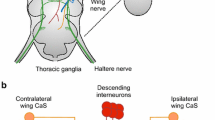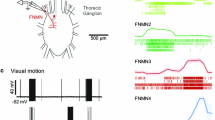Abstract
In the moth Manduca sexta, the paired mesothoracic flight steering muscle II PD2m takes part in the generation of the flight rhythm and is spontaneously active in the non-flying animal. This spontaneous activity is modulated by optomotor stimuli and directionally selective. The directional response characteristics are analyzed. Another spontaneously active steering muscle pair, the III PD2c, is situated in the metathorax. The activities of this pair and of a third muscle pair, the III PD3 are also influenced by visual stimulation.
The responses of all 6 muscles to optomotor stimuli which simulate the flight situations yaw, roll, thrust and lift are analyzed. Each situation elicits a unique pattern of activation/deactivation within this set of muscles. The activity pattern in non-flying animals allows the prediction of flight steering mechanisms such as changes of wing area in flight turns and provides a useful basis for the analysis of visuo-motor pathways.
Similar content being viewed by others
References
Burrows M (1975) Monosynaptic connexions between wing stretch receptors and flight motoneurones of the locust. J Exp Biol 62:189–219
Dombrowski U (1991) Untersuchungen zur funktionellen Organisation des Flugsystems von Manduca sexa. Dissertation, Universität Köln 1991
Dombrowski U, Milde JJ, Wendler G (1990) Visual control of compensatory head movements in the sphinx moth. In: Gribakin FG, Wiese K, Popov AV (eds) Sensory systems and communication in arthropods. Advances in life sciences. Birkhäuser, Basel, pp 127–133
Eaton JL (1971) Morphology of the head and thorax of the adult tobacco hornworm, Manduca sexa (Lepidoptera ∶ Sphingidae). Int J Insect Morphol Embryol 3:47–66
Elson R, Pflüger HJ (1986) The activity of a steering muscle in flying locusts. J Exp Biol 120:421–441
Fischer M, Heide G (1991) Fictive “flight control” in immobilized flies (Calliphora.) In: Elsner N, Penzlin H (eds) Synapse — Trans- mission — Modulation. Thieme, Stuttgart New York, p 64
Fischer HJ, Milde JJ, Wendler G (1990) Characteristics of movement-sensitive descending neurons in the sphinx moth Manduca sexta. In: Elsner N, Roth G (eds) Brain — Perception — Cognition. Thieme, Stuttgart New York, p 80
Hausen K (1982) Motion sensitive interneurons in the optomotor system of the fly. II. The horizontal cells: receptive field organization and response characteristics. Biol Cybern 46:67–79
Heide G (1983) Neural mechanisms of flight control in Diptera. In: Nachtigall W (ed) Insect Flight. BIONA-report 2. Fischer, Stuttgart New York 35–52
Heukamp U (1984) Sensory regulation of the pleuroalar muscles in the migratory locust. Naturwissenschaften 71:481
Horsmann U (1985) Der Einfluß proprioceptiver Windmessung auf den Flug der Wanderheuschrecke und die Bedeutung descen- dierender Neuronen der Tritocerebralkommissur. Dissertation, Universität Köln 1985
Horsmann U, Wendler G (1985) The role of a fast wing reflex in locust flight. In: Gewecke M, Wendler G (eds) Insect locomotion. Parey, Berlin Hamburg, 157–165
Jander JP (1982) Untersuchugen zum Mechanismus und zur zentralnervösen Steuerung des Kurvenlaufs bei Stabheuschrecken (Carausius morosus.) Dissertation, Universität Köln
Kammer AE (1971) The motor output during turning flight in a hawkmoth, Manduca sexta. J Insect Physiol 17:1073–1086
Milde JJ (1988) Neuronal basis of visually guided behavior in Manduca sexta. In: Elsner N, Barth FG (eds) Sense organs. Interfaces between environment and behaviour. Thieme, Stuttgart New York, p 232
Milde JJ (1990) Visual control of compensatory movements in the sphinx moth Manduca sexta. Verh Dtsch Zool Ges 83:419–420
Milde JJ (1991) The role of brain interneurons underlying visual behaviour as revealed by simultaneous recorded muscle activity. In: Elsner N, Penzlin H (eds) Synapse — Transmission — Mo- dulation. Thieme, Stuttgart New York, p 27
Milde JJ, Seyan HS, Strausfeld NJ (1987) The neck motor system of the fly Calliphora erythrocephala. II. Sensory organization. J Comp Physiol A 160:225–238
Milde JJ, Gronenberg W, Strausfeld J (1992) The head-neck system of the blowfly Calliphora: 2. Functional organization and comparisons with the sphinx moth Manduca sexta. In: Berthoz A, Graf W, Vidal PP (eds) The head-neck sensory motor system. Oxford Univ Press, pp pp64–70
Möhl B, Bacon J (1983) The tritocerebral commissure giant (TCG) wind-sensitive interneurone in the locust. lI. Directional sensitivity and role in flight stabilisation. J Comp Physiol A 150:453–465
Müller M, Wendler G (1992) The activity of the third axillary muscles in the sphinx moth Manduca sexta. In: Elsner N, Richter DW (eds) Rhythmogenesis in neurons and networks. Thieme, Stuttgart New York, p 179
Pfau HK (1977) Zur Morphologie und Funktion des Vorderflügels und Vorderflügelgelenks von Locusta migratoria. Fortschr Zool 24:341–345
Pfau HK (1978) Funktionsanatomische Aspekte des Insektenflugs. Zool Jb Anat 99:99–108
Rheuben MB, Kammer AE (1987) Structure and innervation of the third axillary muscle of Manduca relative to its role in turning flight. J Exp Biol. 131:373–402
Rind FC (1983a) A directionally sensitive motion detecting neurone in the brain of a moth. J Exp Biol 102:253–271
Rind FC (1983b) The role of an identified brain neurone in mediating optomotor movements in a moth. J Exp Biol 102:273–284
Robertson RM, Pearson KG (1982) A preparation for the intracellular analysis of neuronal activity during flight in the locust. J Comp Physiol 146:311–320
Rowell CHF, Reichert H (1985) Compensatory steering in locusts: The integration of non-phase locked input with a rhythmic motor output. In: Gewecke M, Wendler G (eds) Insect locomotion. Parey, Berlin Hamburg, 175–182
Scharstein H (1989) A universal projector for optomotor stimulation. In: Elsner N, Singer W (eds) Dynamics and plasticity in neuronal systems. Thieme, Stuttgart New York, p 116
Srinivasan MV, Dvorak DR (1980) Spatial processing of visual information in the movement-detecting pathway of the fly. Characteristics and functional significance. J Comp Physiol 140: 1–23
Suder F (1990) Control of flight orientation by wind and visual inputs in Manduca sexta. In: Elsner N, Roth G (eds) Brain — Perception — Cognition. Thieme, Stuttgart New York, p 79
Wendler G (1972) Posture in insects: its relevance to gravity orientation and mechanisms for its control. Verh Dtsch Zool Ges 65:214–219
Wendler G (1978) The possible role of fast wing reflexes in locust flight. Naturwissenschaften 65:65
Wendler G (1983) The locust flight system: functional aspects of sensory input and methods of investigation. In: Nachtigall W (ed) Insect Flight. BIONA-report 2. Fischer, Stuttgart New York, 113–125
Wendler G (1985) Insect locomotory systems: Control by proprioceptive and exteroceptive inputs. In: Gewecke M, Wendler G (eds) Insect locomotion. Parey, Berlin Hamburg, 245–254
Wolf H (1990) On the function of a locust flight steering muscle and its inhibitory innervation. J Exp Biol 150:55–80
Yamamoto RT (1969) Mass rearing of the tobacco hornworm. II. Larval rearing and pupation. J Econ Entomol 62:1427–1431
Author information
Authors and Affiliations
Rights and permissions
About this article
Cite this article
Wendler, G., Müller, M. & Dombrowski, U. The activity of pleurodorsal muscles during flight and at rest in the moth Manduca sexta (L.). J Comp Physiol A 173, 65–75 (1993). https://doi.org/10.1007/BF00209619
Accepted:
Issue Date:
DOI: https://doi.org/10.1007/BF00209619




